How do dentists view direct access?
An attitudinal survey of dental practitioners covered the impact on dental services and clinical competencies of dental hygienists and therapists
Following a period of consultation and evidence gathering, in May 2013 the General Dental Council (GDC) removed the requirement for patients to be referred by a dentist prior to being seen by a dental hygienist or therapist. Thus, the UK joined a number of other countries in Europe and elsewhere which had developed provision for direct access in one form or another over the last 20 years. 1
The British Dental Association was opposed to this change 2. Earlier research by the authors indicated that dentists were concerned about the education, competence and ability of hygienists and therapists to undertake treatments which had been previously viewed as only within the scope of practice of dentists 3. However, it was unclear how dentists, and particularly general dental practitioners, viewed the reform once it had been implemented and the evidence-base for the decision made public 1 4. The aims of this study were to investigate the perceptions of a representative sample of dentists on the likely impact of direct access on dental services, the extent to which different procedures were viewed as being within the clinical competence of hygienists and therapists acting autonomously, and possible predictors of such views.
For brevity the terms ‘dental hygienists’ and ‘dental therapists’ are used here, although the dental therapists of today are dually qualified in dental hygiene and dental therapy.
Methods
The sampling frame was based on the UK GDC Register, to which the authors were given access under strict conditions of use and confidentiality. The sample size was calculated on the basis of dentists’ likely experience of teamworking, as it was felt that such experience may be an important influence on their views on direct access and issues of clinical competence. It was estimated that approximately 40 per cent of dentists work with a hygienist or therapist. A random sample of 195 was required to reflect this proportion +/- 5 per cent at p=0.05 and 80 per cent power. It was not possible to sample only those working as general dental practitioners or in primary dental care, as this information is not recorded on the GDC register. Data from the GDC register was used to investigate response bias by comparing respondents with non-respondents.
A questionnaire was developed and piloted, covering issues relating to direct patient access to dental hygienists and therapists within the context of their respective scope of practice, including periodontal and preventive treatment, oral health advice, referral for treatment by a dentist and, for therapists, restorative treatment. It also explored the dentist’s experience of working and training with these professionals. Most questions used a five-point response scale i.e. ‘very negative’ to ‘very positive’, or ‘strongly disagree’ to ‘strongly agree’, with space for open-ended comments. The means of values ascribed to items on clinical independent working by hygienists and therapists were computed separately. These summary variables had a range of 1 to 5, with a higher score denoting a more positive view i.e. ‘strongly agree’ with independent working.
In late February 2014, those practitioners for whom the authors had an email address were sent an email introducing the study which contained a hyperlink unique to that individual through which the online questionnaire could be accessed 7. Those without an email address on their GDC record were sent the same information by post. An email reminder to non-respondents was followed by a mailed paper questionnaire sent after the original communication, and a final reminder/thank you email was sent to all 600 included in the original communication.
Results
In total, 159 usable questionnaires were returned, representing a response rate of 27 per cent. There were no significant differences between respondents and non-respondents by gender, UK country of employment, UK vs non-UK dental school attended, specialist status or years since qualification. The 159 respondents included 80 males (50.3 per cent) and 78 females (49.7 per cent). The majority, 125 (78.6 per cent) worked in England, 21 (13.2 per cent) in Scotland, seven (4.4 per cent) in Northern Ireland and four (2.5 per cent) in Wales. One hundred and twenty (75.5 per cent) worked in general dental practice, including 111 (69.8 per cent) with a mixed private/NHS or predominantly NHS patient list. Thirty six (22.6 per cent) were practice owners (63.9 per cent males), while 78 (49.1 per cent) were practice associates (69.2 per cent females).
- Figure 1
- Figure 2
- Figure 3
- Figure 4
Experience of teamwork
The majority of dentists had not undergone any joint undergraduate training sessions with dental hygienists or therapists; 16 (10.2 per cent) had trained with hygienists but not therapists, five (3.2 per cent) had trained with therapists but not hygienists, and 13 (8.3 per cent) had trained with both.
With regard to current or past experience of teamworking, 148 (94.2 per cent) had experience of working with a hygienist and 76 (48.5 per cent) had experience of working with a therapist.
Overall view of Direct Access (DA)
Dentists were asked to indicate their overall view of the GDC decision to allow DA to dental hygienists and for therapists, using a five point Likert-type scale ranging from ‘very unfavourable’ to ‘very favourable’ (Figure 1).
For both sets of responses, a majority held unfavourable views. However, dentists’ views were significantly more unfavourable regarding DA being made available to dental therapists than to hygienists (z=-2.20, p=0.02).
A representative selection of positive and negative comments relating to this overall question are given below and grouped by their general theme.
Positive comments
- Patient benefit (21 comments)
- Re: hygienists (9 comments)
“Because a minority of [the UK population] attend a dentist* and as a nation our oral hygiene is shocking. It stares you in the face every day, all social classes.”
Salaried dentist
*In fact in 2012-13 just under half of the adult population had not attended a GDP in the previous two years 8.
“In many cases, this is all the patient needs and it can reduce the time taken by dentists doing scale and polishes and non-surgical periodontal treatment to leave time for other treatment.”
Male associate
“Well trained, professional person can see patients easily.”
Practice owner
“A dental practice operating with hygienists is ideal. It will cover and provide good general dentistry with hygiene and a solid base for referral for specialists if and when necessary and will serve the population very well.”
Senior partner
- Re: Therapists (13 comments)
“Personal experience of how good they are.”
Respondent 47, female salaried dentist, qualified 1980
“Highly qualified professionals.”
Practice owner
“Workload reduced for dentist.”
Practice owner
“Patients can get good basic care at the right time without delay caused during waiting for GDP appointments.”
Salaried dentist
Negative comments
- Patient safety (23 comments)
- Re: hygienists (11 comments)
“People will take the easier and cheaper option of visiting the hygienist and believe they have had a dental check-up. Therefore pathology stays undiagnosed.”
Practice owner
“I am worried about patients avoiding dentists for years, in favour of hygienists who are unable to diagnose and manage a range of dental diseases.”
Associate
“[It] could affect [patient] care with regard to dental issues other than perio, e.g. oral cancer screening/ caries etc.”
Associate
“[Patients] may just attend hygienist rather than attending for routine dental appointments which could result in caries.”
Associate
- Re: therapists (12 comments)
“I think patients should have a proper exam with a dentist to determine the treatment plan with x-ray if necessary and/or prescribed medication.”
Associate
“I think it will confuse patients and put some at risk of being incorrectly diagnosed and treated.”
Associate
“To diagnose and carry out restorative treatment with no regular dentist exam may lead to under/over diagnoses going unchecked. At least yearly dentist check-ups to make sure nothing getting missed.”
Practice owner
“Patients may be under the false impression they do not need to see their dentist if seen by therapists.”
Associate
- Undermining the dentist’s role, poor service planning
- Re: hygienists (4 comments)
“I consider this to be a diluting of my profession.”
Practice owner
“Patients will be confused by each team member’s role.”
Salaried dentist
“It’s an attempt to meet a need for areas where NHS dental access is poor by providing a service which isn’t dentistry. Instead the reasons why dentists left NHS dentistry in these areas should have been addressed.”
Associate
“The huge raft of regulations make it quite difficult to run an operation for a hygienist. Possible problem of incentivised referrals to certain professionals. There are no NHS contracts for hygienists so it will all be private.”
Associate
- Re: therapists (9 comments)
“The decision making process was pushed through ignoring dentists.”
Corporate dentist
“No good evidence to support the decision.”
Specialist
“I feel there was nothing wrong with the previous system of patients being seen first by dentist then referred on to the therapist.”
Salaried dentist
- Cost-cutting (3 comments re: Therapists)
“I feel dentists are being pushed out of the NHS as a cost saving exercise.”
Salaried dentist
“Because cost motivates this decision. Not patient welfare.”
Practice owner
“They represent the views of government cuts.”
Male associate
Figure 2 indicates views on the impact of DA on specific aspects of dental services in relation to hygienists, ordered by perceptions of the level of benefit, from least beneficial to most beneficial. Figure 3 shows the same information in relation to therapists, with one extra item relating to restorative treatment. The lower Chronbach’s alpha score in relation to the items concerning therapists implies a less consistent view of the likely impact of independent working by therapists, with dentists indicating it would be beneficial in some respects and harmful in others.
- Impact on dentists’ workload
Views about the potential impact on dentists’ workload were equivocal (Figure 4).
The potential benefit was often viewed in terms of more appropriate specialisation of roles.
“Allows us to concentrate on more complex cases, cutting waiting times for such treatments.”
Practice owner (re: hygienists)
“Dentists able to see more patients for check ups without time being wasted doing simple restorative treatment.”
Salaried dentist (re: therapists)
“Dentists will expect therapist to carry out less well remunerated work to free them up for other treatments.”
Practice owner (re: therapists)
“Transfer of focus onto elements of dentistry that dentists may only perform.”
Corporate dentist (re: therapists)
- Harm was mainly related to a reduction in workload and therefore income. All eight comments refer to therapists:
“I think GDPs will be pushed out the NHS.”
Salaried dentist
“The country has trained enough dentists. If management was optimal, access shouldn’t need more providers. The dentists who pump out UDA’s without a good level of care will no doubt employ more therapists to reduce their costs, lower their level of care.”
Practice owner
“There are already too many dentists treating too few patients, adding more professionals will exacerbate the problem.”
Salaried dentist
“They are stealing part of my role and also my income!”
Associate
“Patients will deem that attending a hygienist or therapist is cheaper and so the patients will want the hygienist or therapist to do the same job but cheaper.”
Associate
“As they would be cheaper to employ, practice principles (sic) could tend to favour them to do the bulk of the work in order to profit more personally.”
Associate
“More providers the same demand.”
Practice owner
“Reduce potential for private work.”
Associate
Referrals from hygienists and therapists
Dentists were asked for their reaction to the possibility of receiving referrals from hygienists and therapists for treatments that were outwith their scope of practice.
Here, respondents were generally favourable to such teamworking (Figure 5).
Clinical competence and DA
A series of questions investigated dentists’ views on the clinical competence of hygienists and therapists to work without a prescription from a dentist (Figure 6).
A substantial majority expressed concerns. There was no significant difference between the two sets of responses (z=-1.47, p=0.14 (n.s.) excluding ‘can’t say’ responses).
More detail on the nature of such concerns was sought by asking the extent to which dentists agreed or disagreed with hygienists and therapists being permitted to undertake a range of procedures. Figures 7 and 8 illustrate their responses, ordered by level of agreement, which is shown in green.
- Figure 5
- Figure 6
- Figure 7
- Figure 8
NHS list/performer numbers
At present NHS list numbers are restricted to dentists. Only 20 (12.7 per cent) agreed that they should be de-restricted while 95 (60.1 per cent) disagreed and 43 (27.2 per cent) were unsure. Comments made by the first group mainly emphasised widening patient access to treatment and greater division of labour, and the cost savings this could bring. Comments by those in the second group covered three main themes: quality of care, dentists’ role as the mainstay of dental care, and workforce issues.
Predictors of polarity of views on DA
The two variables summarising dentists’ views on clinical independent working had a mean of 3.08, sd 0.94, n=156 for hygienist-performed treatments, and 2.99, sd 0.92, n=156 for therapists. The two scores correlated at r=0.66, p=0.001, n=156. The only significant association found was between GDS status and views on DA for therapists. The 44 practice owners and senior partners tended to have a more positive view of therapists working without a dentist’s prescription than did the 77 associates (mean 3.32 vs mean 2.89, p=0.037, with Bonferroni correction).
Discussion
The overall response rate to the survey was poor (27 per cent), but perhaps not atypical. For example, a recent survey of UK General Dental Practitioners (GDPs) achieved a response rate of 31 per cent 9. Pressure of work, office policy, and frequent requests to complete commercial surveys have been cited as reasons for poor response rates amongst dentists 10. While methodological reviews suggest features such as brevity or incentives may increase response rates 11, this may not be the case for surveys of dentists 12, 13.
Low response raises the possibility of response bias and threats to the validity and generalisability of the findings. However it has been argued that non-response is a source of error only if responders and non-responders differ in crucial ways 14, 15. There was no response bias in regard to gender, UK country of employment, UK/non-UK dental school attended, specialist status, or years since qualification. Experience of team-working was similar to the level indicated by published GDC statistics. However this does not necessarily mean that responders and non-responders were similar in relevant attitudes and beliefs, and that non-responders were ‘missing at random’ 14.
The findings of the study should therefore be interpreted with caution. As Figures 2 and 3 show, dentists’ views on the impact of more independent clinical working varied considerably. For ‘traditional’ hygienist and therapist activities, positive responses tended to outnumber negative ones, and, taken with the considerable numbers of neutral responses, indicate that most dentists were either favourable or impartial regarding the implications of the DA reform. However, this was not true for procedures often seen as within the dentist’s sole remit. Referral decisions, risk assessment, diagnosis and treatment planning, and, for therapists, restorations, were felt by a majority to be inappropriate treatments to be undertaken without a dentist’s prescription (Figures 7 and 8).
Attitudes regarding hygienists and therapists performing a range of treatments without a dentist’s prescription were difficult to predict. Gender, years since qualification, sector of employment and, perhaps most surprisingly, previous or current experience of working with a hygienist or therapist, were irrelevant in this respect. However, among general dental practitioners, associates were significantly more negative towards therapists performing a range of treatments without a dentist’s prescription than were practice owners. This may reflect associates’ concern over role substitution by therapists.As one practice associate put it: “It will put associates at risk of unemployment.”
The numerous comments should be seen as indicative of the views and attitudes of some dentists rather than necessarily representative of the majority. Although some positive observations were made, it would appear that there is still much concern and distrust surrounding hygienists and therapists working with greater autonomy. A variety of reasons were put forward, including patient safety, lack of training, and the reform being cost rather than quality driven.
Patient safety was cited by the GDC as the foremost consideration in relation to the DA reform. While two recent reviews 1, 15 of the research evidence regarding the comparative performance of dentists and DCPs found no evidence that patient safety was at risk, both refer to a shortage of recent good quality comparative studies, and were unable to reach any firm conclusions about the relative effectiveness of dental auxiliaries and dentists.
In the present study, references to patient safety most commonly cited the possibility of missed pathology, which depends largely on the level of training received by therapists and hygienists.
The educational process of dental hygienists and hygienist-therapists has changed exponentially in recent years. Most establishments in the UK now offer a three or four-year BSc or BSc (Hons) degree in Oral Health Sciences. The learning outcomes contained within the GDC curriculum guidance document ‘Preparing for Practice’ are almost identical for dentists, hygienists and hygienist-therapists, within their respective scope of practice 16. A number of subject areas are taught jointly with BDS undergraduates, as the level of knowledge required of each group is the same. It could be argued that because of their narrower curriculum, hygienists and therapists spend more time in a clinically supervised environment developing their skills in routine dentistry than do undergraduate dental students. The dissemination of information on curricula and Scope of Practice may also help allay dentists’ concerns, as may a greater emphasis on joint training during programmes of Continuing Professional Development.
Dentists’ concerns about hygienists’ and therapists’ standards of operative dentistry may therefore be due to dentists’ lack of awareness of their curricula, which suggests that education regarding the quality and extent of training and resulting clinical competence of therapists and hygienists may be required. As one respondent admitted: “We don’t know their level of training.”
Other comments related to the possible financial disadvantages for dentists. There were concerns that there would be a reduced potential for their own private work, and that their role and/or income would be significantly reduced as a result of increased competition. Such concerns are not supported by evidence from abroad, or from medical general practice in the UK, which has seen the emergence of several groups of allied health professionals which work very successfully in their areas of expertise and in tandem with others without detriment to GPs’ income (or indeed to patient safety) 1, 17, 18.
The 2013 Direct Access reform has served to highlight several areas of regulatory restriction to which hygienists and therapists working in the NHS are still subject. These principally involve prescribing rights in terms of the use of local anaesthesia and fluoride-containing agents, and reporting on radiographic findings. In addition, NHS regulations still permit only dentists to hold a list or performer Number which dictates that any hygienist or therapist wishing to set up in independent practice can only do so on a private patient basis.
Perhaps the time has also come to explore other options for the delivery of dental education. While there is much commonality among the BDS and BSc curricula, they continue to remain separate in many ways. We exist in a totally different educational and professional environment, and the BDS programme continues perhaps without sufficient recognition that both the workforce and the oral health needs of the population are changing.
Such prohibitive regulations and inadequately integrated educational programmes now appear outdated. The 2013 Direct Access reform may only be the first step towards the provision of a more flexible, comprehensive and coordinated oral health care service which will be required to meet the evolving needs of the public 19, 20.
About the authors
Margaret Ross, senior lecturer for DCPs, Edinburgh Dental Institute, University of Edinburgh.
Stephen Turner, senior researcher, Scottish Dental Practice Based Research Network.
This article is an edited version of the paper published in the British Dental Journal entitled ‘Direct access in the UK: what do dentists really think?’ Ross MK, Turner S. 2015. Br Dent J, 129: 641-647
References
1. Turner S, Tripathee S and Macgillivray S (2013) Direct access to DCPs: What are the potential risks and benefits? Br Dent J 215(11): p577-82. DOI: 10.1038/sj.bdj.2013.1145
www.nature.com/bdj/journal/
2. GDC announces controversial decision on direct access. Br Dent J 2013; 214: 379.
3. Ross, MK, Ibbetson, R, and Turner, S (2007). The acceptability of dually-qualified dental hygienist-therapists by General Dental Practitioners in South East Scotland. Br Dent J; 202, 146-7
4. Turner S, Tripathee S and Macgillivray S (2012) Benefits and Risks of Direct Access to Treatment by Dental Care Professionals: A Rapid Evidence Review. General Dental Council. www.gdc-uk.org/Newsandpublications/research/Pages/research.aspx
5. Turner S, Ross, MK and Ibbetson, R (2011) Dental hygienists and therapists: how much professional autonomy do they have? How much do they want? Results from a UK survey. Br Dent J; May 28;210(10):E16.
6. Bristol Online Surveys. http://www.survey.bris.ac.uk
7. Hardigan PC, Succar CT, Fleisher JM. An analysis of response rate and economic costs between mail and web-based surveys among practicing dentists: a randomized trial J Community Health. 2012 Apr;37(2):383-94. doi: 10.1007/s10900-011-9455-6.
8. NHS Dental Statistics for England – 2012-13, Health and Social Care Information Centre,
16:31 March 24, 2015 – 09:30 September 17, 2013, September 17, 2013. www.hscic.gov.uk/catalogue/PUB11625 (accessed 23 March 2015).
9. Glidewell L, Thomas R, MacLennan G, Bonetti D, Johnston M, Eccles M et al. Do incentives, reminders or reduced burden improve healthcare professional response rates in postal questionnaires?: Two randomized controlled trials. BMC Health Services Research. 2012 Aug 14;12. 250. Available from: 10.1186/1472-6963-12-250.
10. Cook JV, Dickinson HO and Eccles MP. Response rates in postal surveys of healthcare professionals between 1996 and 2005: an observational study. BMC Health Serv Res 2009;9:160.
11. Edwards PJ, Roberts I, Clarke MJ, DiGuiseppi C, Wentz R, Kwan I, Cooper R, Lambert M F, and Pratap S Methods to increase response to postal and electronic questionnaires. Cochrane Database of Systematic Reviews 2009, Issue 3. Art. No.:MR000008. DOI:10.1002/14651858.
12. Shelly AM, Brunton P and Horner K. Questionnaire surveys of dentists on radiology. Dentomaxillofacial Radiology 2012, 41, 267-275.
13. Parashos, P; Morgan, MV; Messer, HH. Response rate and nonresponse bias in a questionnaire survey of dentists. Community Dentistry and Oral Epidemiology; Feb, 2005; 33; 1; p9-p16
14. Locker D. Response and nonresponse bias in oral health surveys. J Public Health Dent. 2000;60(2):72-81.
15. Dyer T, Brocklehurst P, Glenny AM, Davies L , Tickle M, Issac A, and Robinson PG (2014) Dental auxiliaries for dental care traditionally provided by dentists. Cochrane Database Syst Rev. 2014 Aug 20;8:CD010076. doi: 10.1002/14651858.CD010076.pub2.
16. Preparing for Practice. General Dental Council (2011) www.gdc-uk.org/newsandpublications
17. Northcott A, Brocklehurst P , Jerkoviosi K, Reinders JJ, McDermott I and Tickle M (2013) Direct access: lessons learnt from the Netherlands. Br Dent J, Dec 21, 215 ( 12) 607-610.
18. Laurant M, Reeves D, Hermens R, Braspenning J, Grol R, Sibbald B. (2012) Substitution of doctors by nurses in primary care (review). Cochrane Database of Systematic Reviews. Art No: CD001271. The Cochrane Collaboration, John Wiley & Sons.
19. Macey R, Glenny A, Walsh T, Tickle M2, Worthington H, Ashley J and Brocklehurst P (2015) The efficacy of screening for common dental diseases by hygiene-therapists: a diagnostic test accuracy study. J Dent Res 94(3 Suppl):70S-8S. doi: 10.1177/0022034514567335. Epub 2015 Jan 20.
20. Ross M (2015) Muddy Water or a Clear Horizon? Faculty Dental Journal, 6, 74-77. Royal College of Surgeons of England.

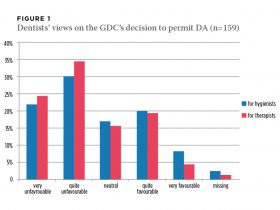
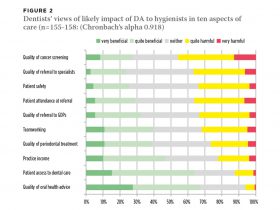
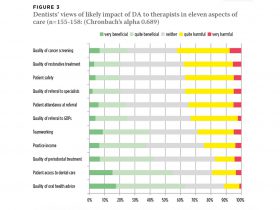
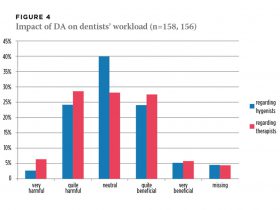
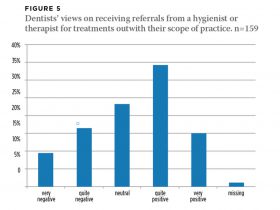
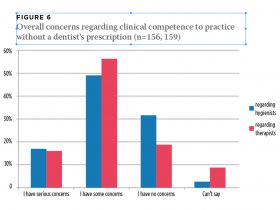
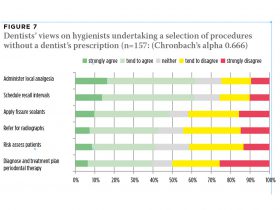
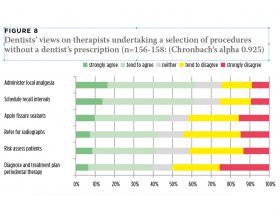
Comments are closed here.